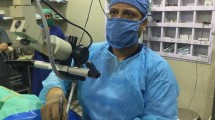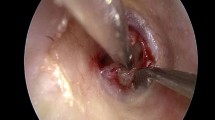Abstract
The tympanic membrane retraction pocket is a pathological invagination of tympanic membrane into the middle ear space. The most common sites for formation of retraction pocket are pars flaccida and postero-superior parts. Decision about the procedure and the timing of the treatment of retraction pockets is debatable and depends on the functional and anatomic condition of the ear. To evaluate the results of the technique of two handed endoscopic management of retraction pockets with sliced tragal cartilage. Prospective Non Randomized Clinical Study. The study included 41 ears operated with the technique of two handed endoscopic cartilage tympanoplasty for retraction pockets with endoscope holders from November 2013 to May 2016 with a follow up period ranging from 22 to 53 months. Cases of cholesteatoma and tympanic membrane perforation were excluded from the study. Pre and postoperative symptoms and air–bone gaps were recorded. The average preoperative air–bone gap in the study group was 24.53 ± 4.326 dB. 28 ears were of pars tensa retractions (stage II-4, stage III-15, and stage IV-9) and 13 were pars flaccida retractions (stage III-8 and stage IV-5). 24 ears had ossicular erosion. The follow up revealed that, the results of two handed endoscopic sliced cartilage tympanoplasty for retraction pockets were stable and there was no recurrence of the retraction and the post-operative air–bone–gap closure was achieved to 13.62 ± 4.78, 14.13 ± 5.91 dB, 14.32 ± 3.46 and 14.57 ± 3.88 dB at 6 months, 1 year, 2 years, 3 years respectively. Though, indications for surgery are based mostly on anatomic status and observation of behaviour of retraction pocket over time, we recommend early management of retraction pockets by the technique of endoscopic sliced tragal cartilage tympanoplasty with tragal cartilage of 0.5 mm thickness using endoscope holder.
Level of Evidence: Level 4.






Similar content being viewed by others
References
Michaels L (1989) Biology of cholesteatoma. Otolaryngol Clin North Am 22:869–881
Yoon TH, Schachern PA, Paparella MM, Aeppli DM (1990) Pathology and pathogenesis of tympanic membrane retraction. Am J Otolaryngol 11(1):10–17
Li Y, Hunter LL, Margolis RH, Levine SC, Lindgren B, Daly K, Giebink GS (1999) Prospective study of tympanic membrane retraction, hearing loss, and multifrequency tympanometry. Otolaryngol Head Neck Surg 121(5):514–522
Maw AR, Bawden R (1994) Tympanic membrane atrophy, scarring, atelectasis and attic retraction in persistent, untreated otitis media with effusion and following ventilation tube insertion. Int J Pediatr Otorhinolaryngol 30(3):189–204
Sade J, Berco E (1976) Atelectasis and secretory otitis media. Ann Otol Rhinol Laryngol 85(2 Suppl 25 Pt 2):66–72
Mierzwiński J, Fishman AJ (2014) Retraction pockets of tympanic membrane: protocol of management and results of treatment. Otorynolaryngologia 13(2)
Huy PTB (2005) Otites moyennes chroniques. Histoire e´le´mentaire et formes cliniques. EMC-Oto-rhino-laryngologie 2(1):26–61
Ars BM (1991) Tympanic membrane retraction pockets. Etiology, pathogeny, treatment. Acta Otorhinolaryngol Belg 45(3):265–277
Kasbekar AV, Patel V, Rubasinghe M, Srinivasan V (2014) The surgical management of tympanic membrane retraction pockets using cartilage tympanoplasty. Indian J Otolaryngol Head Neck Surg 66(4):449–454
Akyildiz N, Akbay C, Ozgirgin ON, Bayramoglu I, Sayin N (1993) The role of retraction pockets in cholesteatoma development: an ultrastructural study. Ear Nose Throat J 72(3):210–212
Ramakrishnan Y, Kotecha A, Bowdler DA (2007) A review of retraction pockets: past, present and future management. J Laryngol Otol 121:521–525
Bours AF, Decat M, Gersdorff M (1998) Our classification of tympanic retraction pockets. Acta Otorhinolaryngol Belg 52(1):25–28
Sadæ J, Avraham S, Brown M (1981) Atelectasis, retraction pockets and cholesteatoma. Acta Otolaryngol 92(5–6):501–512
Tos M, Poulsen G (1980) Attic retractions following secretory otitis. Acta Otolaryngol 89:479–486
Sade J (1979) The atelectatic ear. In: Sade J (ed) Monograms in clinical otolaryngology, secretory otitis media and its sequelae. Churchill-Livingstone, New York, pp 64–88
Alzahrani M, Saliba I (2014) Tympanic membrane retraction pocket staging: is it worthwhile? Eur Arch Oto-Rhino-Laryngol 271(6):1361–1368
Chiossone E (1995) Preventive tympanoplasty in children: a new approach. Rev Laryngol Otol Rhinol (Bord) 116(2):137–139
Khan MM, Parab SR (2016) Novel concept of attaching endoscope holder to microscope for two handed endoscopic tympanoplasty. Indian J Otolaryngol Head Neck Surg 68(2):230–240
Khan MM, Parab SR (2015) Concept, design and development of innovative endoscope holder system for endoscopic otolaryngological surgeries. Indian J Otolaryngol Head Neck Surg 67(2):113–119
Khan MM, Parab SR (2016) Endoscopic cartilage tympanoplasty: a two-handed technique using an endoscope holder. Laryngoscope 126:1893–1898. https://doi.org/10.1002/lary.25760
Khan MM, Parab SR (2011) Primary cartilage tympanoplasty: our technique and results. Am J Otolaryngol 32(5):381–387
Khan MM, Parab SR (2013) Reinforcement of Sliced Tragal Cartilage Perichondrium Composite Graft with Temporalis Fascia in Type I Tympanoplasty: Our Techniques and Results. J Rhinol-Otol 1:57–62
Khan MM, Parab SR (2012) Day care ear surgery: our experience of 4 years. Indian J Otolaryngol Head Neck Surg 64(3):280–284
Khan MM, Parab SR (2014) Sliced Island tragal cartilage perichondrial composite graft: early results and experience. J Rhinol-Otol 2:4–9
Khan MM, Parab SR (2015) Comparative study of sliced tragal cartilage and temporalis fascia in type I tympanoplasty. J Laryngol Otol 129(1):16–22
Khan MM, Parab SR (2015) Average thickness of tragal cartilage for slicing techniques in tympanoplasty. J Laryngol Otol 129(05):435–439
Parab SR, Khan MM (2018) New cartilage slicer for slicing techniques in tympanoplasty: design and applications. Indian J Otolaryngol Head Neck Surg. https://doi.org/10.1007/s12070-018-1467-4
Charachon R, Barthez M, Lejeune JM (1992) Spontaneous retraction pockets in chronic otitis media medical and surgical therapy. Ear Nose Throat J 71(11):578–583
Singh I (ed) (2004) Textbook of human histology. New Delhi: Jaypee Brothers Medical Publishers. 89–93
Zahnert T, Huttenbrink KB, Murbe D et al (2000) Experimental investigations of the use of cartilage in tympanic membrane reconstruction. Am J Otol 21:322–328
Author information
Authors and Affiliations
Corresponding author
Ethics declarations
Ethical Approval
All procedures performed in studies involving human participants were in accordance with the ethical standards of the institutional committee and with the 1964 Helsinski declaration and its later ammendments or comparable ethical standards.
Conflict of interest
None.
Informed Consent
Informed consent was obtained from all individual participants included in the study.
Additional information
Publisher's Note
Springer Nature remains neutral with regard to jurisdictional claims in published maps and institutional affiliations.
Electronic Supplementary Material
Below is the link to the electronic supplementary material.
Rights and permissions
About this article
Cite this article
Parab, S.R., Khan, M.M. Endoscopic Management of Tympanic Membrane Retraction Pockets: A Two Handed Technique with Endoscope Holder. Indian J Otolaryngol Head Neck Surg 71, 504–511 (2019). https://doi.org/10.1007/s12070-019-01682-2
Received:
Accepted:
Published:
Issue Date:
DOI: https://doi.org/10.1007/s12070-019-01682-2




